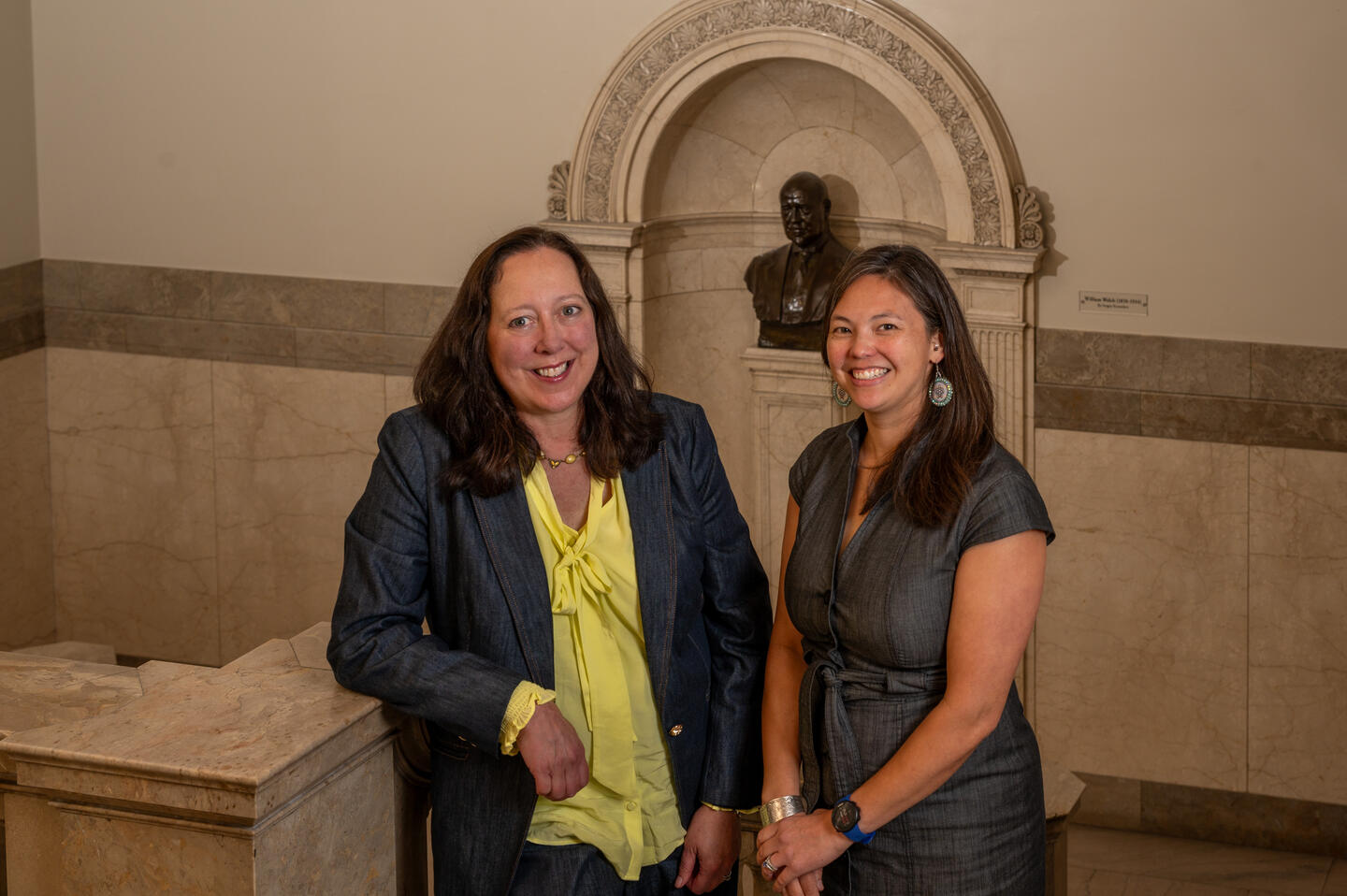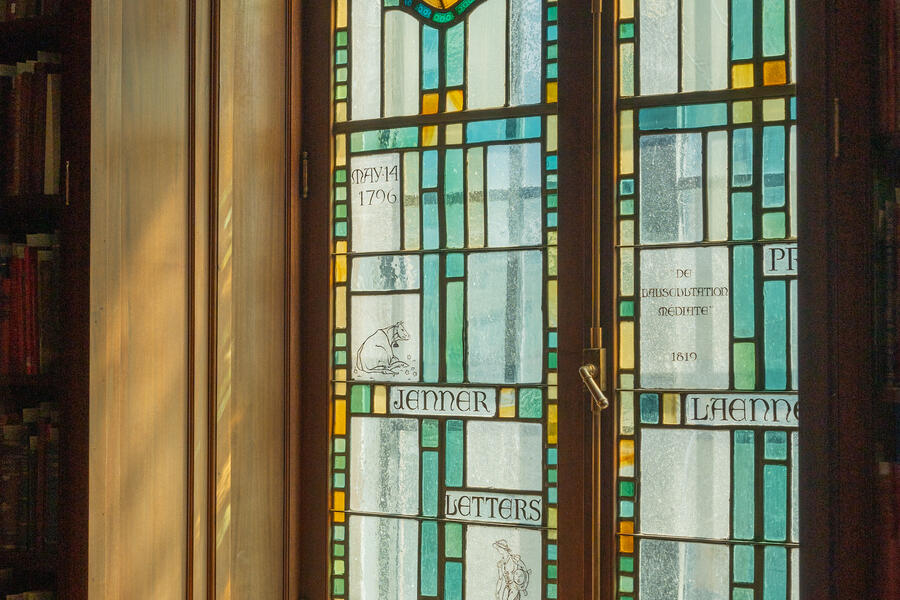Anne Seymour enjoys explaining that the William H. Welch Medical Library not only houses books, but is actually built on them.
On a tour of its basement stacks, the associate dean points out rows of stout, floor-to-ceiling metal bookshelves bolstered at either end by the kind of iron I-beams that support skyscrapers.
She says that when she was investigating how to open up the space for new uses, she quickly learned that the shelves holding the leather-bound, long-ago-published medical and scientific books and journals were also holding up the rest of the historic building at 1900 East Monument St. in East Baltimore.
"Those things aren't going anywhere," she says with a laugh. "They're the foundation."

Image caption: Associate Dean Anne Seymour and Associate Director of Informationist Services Beth Whipple lead the Welch Medical Library
Image credit: Mike Ciesielski for Johns Hopkins University
Seymour came to Johns Hopkins from the University of Pennsylvania in 2014 to lead the Welch Library. She holds faculty appointments in The Johns Hopkins University's schools of medicine, nursing, and public health. Throughout her career, she's focused on using the latest technology in digital systems to share quality, evidence-based information with clinics, research labs and classrooms.
A visit to the Welch website offers anyone with a Johns Hopkins Enterprise Directory (JHED) ID access to Scopus, a massive multidisciplinary database of academic abstracts and citations. Also available are biomedical and health databases, free online workshops and research guides on specific topics, as well as access to thousands of journals, textbooks, and clinical resources. "Obviously, no one uses libraries in the same way they used them 20 or 30 years ago," Seymour says. "The challenge in the field of library and information science is how to adapt to the changes in ways that people access and use information."
Garrett, 'The Four Doctors', and cigar smoke
The Welch Medical Library is also home to the famous portrait of William Welch, William Halsted, William Osler, and Howard Atwood Kelly, painted by famous American portraitist John Singer Sargent in 1906. "The Four Doctors" portrays the quartet of medical pioneers and early Johns Hopkins University School of Medicine faculty members in their academic regalia. The painting was commissioned by Johns Hopkins University School of Medicine founding benefactor Mary Elizabeth Garrett, whose own Sargent portrait also hangs in the Welch's West Reading Room.
Seymour says "The Four Doctors" is due for professional cleaning and touch-ups, after decades of hanging in a room that has hosted innumerable ceremonies, dinners, and other functions. She says caterers used to place steam tables full of food directly under the historic painting.
"Can you imagine?" she asks, wide-eyed. "Also, years and years of cigar smoke" from evening faculty receptions in the years when smoking was an acceptable part of social occasions took a minor toll on the paintings.
While the priceless artwork and hundreds of thousands of books have never left the Welch, fewer students and faculty have visited the building since many of its vital services became available online. A year before Seymour's arrival, most of the library's staff moved one block east to offices in a converted department store at 2024 East Monument St. Because space in the Welch was cramped and fewer people needed in-person services, the relocation made sense.

Image caption: Welch Medical Library informationist Marcus Spann and his colleagues help researchers, students, and clinicians navigate the library’s vast resources, as well as offer classes and workshops on everything from search terms to academic publishing.
Image credit: Mike Ciesielski for Johns Hopkins University
"Our digital collection and all our online subscriptions are wonderful resources," Seymour says. "But I think of the library staff, both forward-facing and behind the scenes, as one of the cornerstones of the research that happens at Johns Hopkins." Roy Ziegelstein, vice dean for education at the Johns Hopkins University School of Medicine, agrees.
"Although the Welch Medical Library building is magnificent, it is not the structure itself but rather what occurs and has occurred in the building that make it unique," says Ziegelstein, who has spent his whole academic career at Johns Hopkins. "Yes, there are books, journals, stacks, classic works of art, and historical displays, but it is the culture of the place that makes up the special sauce."
Now, thanks to the hybrid work schedules that have followed the COVID-19 pandemic, Seymour and her team are repopulating the Welch, and the historic library is beginning to bustle again for the first time in years.
"My goal is to bring some life back to this building," Seymour says from her office on the Welch's first floor. She and her team host events, book clubs, coordinate exhibits, and take part in "Love Data Week," an annual international celebration of all things data.
"I've had several staff people tell me how happy they are to be back in this building," she says. "We're definitely still tight for space. But because of hybrid schedules, we're able to make it work pretty well."
A modern model for research
Though little has changed in the 1929 building itself, a new model for academic and medical library science has emerged at the Welch Library. In the early 2000s, changes in academic publishing drove many institutions to hire library workers trained in both academic library science and clinical or public health fields who could serve as research collaborators.
Such "informationists" possess enough scientific knowledge to work with faculty and student researchers on their scholarly publications.
An early adopter of the informationist model, the Welch remains one of the academic medical libraries most committed to the concept. Among the nearly 40-person staff are 13 informationists, each of whom serves multiple clinical and research departments and divisions.
"I'm not a physician but I'm providing expert-level search requests for physicians," says Marcus Spann, whose specialty areas include clinical pharmacology, neurology, neurosurgery, and general internal medicine. "I spend a lot of time exploring their world, learning a lot of medical terminology and trying to get at exactly what they want."
In August, Seymour hired librarian Beth Whipple from the Indiana University School of Medicine to serve as the Welch's associate director of informationist services. Whipple stresses that understanding how information is organized is a valuable benefit her team can bring to a research project.
"I think of the informationist as a kind of embedded librarian," says Whipple, adding that many research teams begin a project with a broad range of questions. "When we're involved from the beginning, we're better able to help the team refine exactly what their question is and make sure it's specific. We'll help them structure their database searches and get to the right information."
When Johns Hopkins researchers set out to conduct a systematic review, a Welch informationist often handles much of the heavy lifting, performing exhaustive searches through huge discipline-specific databases, relevant datasets, and other sources. Often when a journal article is finally published, the informationist is credited among the article's authors. Seymour notes proudly that the Welch's informationist team set an in-house record for publication credits in 2023, appearing in 60 different peer-reviewed journal articles.
Their work isn't limited to research. Clinicians facing complex or unusual cases also tap the Welch team for information related to their patients.
"Now and then, we'll get a follow-up note from a physician or a surgeon telling us we helped save a patient's life," says Seymour. "That's pretty special."
Johns Hopkins informationists also teach courses designed to help researchers learn how to search complex databases with the answers they need.
Teaching an online class called PubMed: Search Like a Pro, Spann guides students through the NIH's National Library of Medicine's PubMed platform, which contains more than 37 million citations and abstracts of biomedical and life sciences literature. Other Welch informationists teach courses in areas like data visualization, gene-based information on the web, and the basics of publishing articles in scholarly journals.
"I try to empower the user," Spann says. "I stay attentive to their needs, but also I try to make sure they're not completely dependent on me to feed them by hand. It's very rewarding when someone I've worked with can sort of fly on their own, so to speak."
A hub of medical history
Along with the newest advances in library science, the Welch also features the oldest department of the history of medicine in North America. In addition to historic publications by such scientific pioneers as Louis Pasteur, Francois Rabelais, and Edward Jenner, the Institute of the History of Medicine contains rare volumes published as early as the 15th century, soon after Johannes Gutenberg invented the moveable-type printing press.
Michael Seminara, the institute's curator, pulls out a leather-bound volume published in 1668 by a priest named Candido Brognoli Bergomense. The book instructs readers on which ailments require a physician and which require an exorcist. "This is one of my favorites," Seminara says. "It really demonstrates what people in those years knew about medicine and how the field sometimes involved things like evil spirits or demons."

Image caption: The stacks in the basement of the Johns Hopkins Welch Medical Library are built to support the rest of the building.
Image credit: Mike Ciesielski for Johns Hopkins University
He also calls attention to several glass cases containing such ephemera of medical history as a set of 19th-century phrenology models and an elegant, velvet-lined wooden box full of turn-of-the-century surgical tools.
In all, the History of Medicine collection contains about 70,000 volumes, 20,000 images, and thousands of objects and artifacts, including a 226-year-old clipping of fur that belonged to Blossom, the cow from which the first vaccines for smallpox were derived.
"These are the sorts of thing that make history real," Seminara says. "How many lives did those vaccines save? And right here is the source. It's a pretty remarkable historic artifact."
It doesn't get old
When researchers know they'll require many hours of help from an informationist, the Welch team may ask that their work be written into the research funding grant. But much of the work they do is simply part of the services offered at the Welch.
"Think of how many conversations have occurred there that have changed human history," says Ziegelstein. "Think of the discoveries that have been catalyzed by a critical piece of evidence unearthed by a careful search through the library's contents, perhaps guided by an expert informationist."
Seymour says working with researchers who are taking on the toughest problems in the health sciences and clinical care doesn't get old.
"Oh, I definitely love it," she says. "The work is always different, it's very dynamic. Libraries are more than just collections. All of the folks in the library help make sense of information, how to access it and how it's organized."
Welch Medical Library facts
The Welch Medical Library was designed by New York architect Edward Tilton.
Construction completed in May 1928 and the building was dedicated in October 1929.
The first director was Lt. Col. Fielding Harrison, of the U.S. Surgeon General's library.
Anne Seymour is the eighth director of the Welch Medical Library and the only director appointed associate dean.
The Johns Hopkins University's schools of medicine, nursing and public health scholars have access to nearly 350,000 books and bound journals, as well as 150,000 online journals, more than 1,200 databases and nearly a million e-books.
There were more than 375,000 views of online guides in fiscal year 2024.
Posted in Arts+Culture, University News








